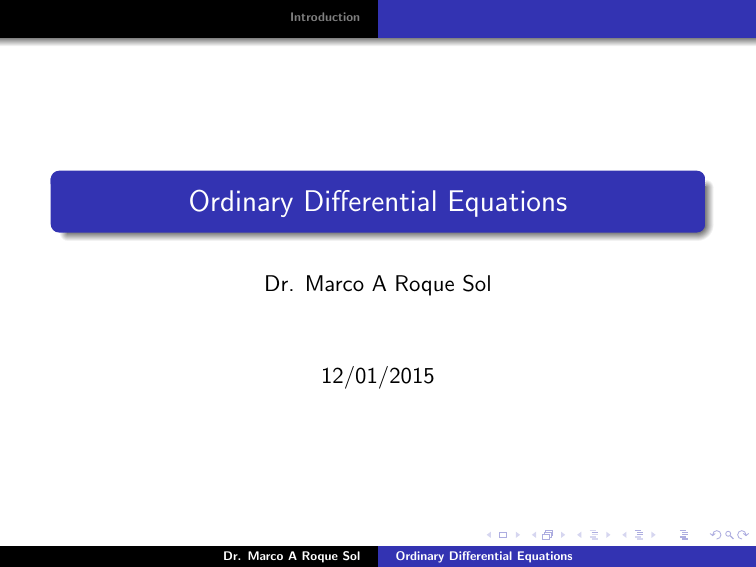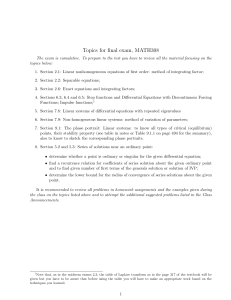Ordinary Differential Equations Dr. Marco A Roque Sol 12/01/2015 Introduction
advertisement

Introduction Ordinary Differential Equations Dr. Marco A Roque Sol 12/01/2015 Dr. Marco A Roque Sol Ordinary Differential Equations Introduction Table of contents Introduction First Order Differential Equations Second Order Differential Equations Higher Order Differential Equations Series The Laplace Transform System of First Order Linear Differential Equations Nonlinear Differential Equations Dr. Marco A Roque Sol Ordinary Differential Equations Introduction Definitions Classification Introduction Figure: Sophus Lie. Dr. Marco A Roque Sol Ordinary Differential Equations Introduction Definitions Classification Definitions Differential Equations A differential equation is any equation which contains derivatives, either ordinary or partial derivatives. There many situations where we ca find such an object. Thus, for instance in the case of the study of Classical Mechanics in Physics, if an object of mass m is moving with acceleration a and being acted on with force F then Newtons Second Law tells us. F = ma Dr. Marco A Roque Sol Ordinary Differential Equations Introduction Definitions Classification Definitions To see that this is in fact a differential equation. First, remember that we can rewrite the acceleration, a, in one of two ways. dv d 2u or a = 2 dt dt Where v is the velocity of the object and u is the position function of the object at any time t. We should also remember at this point that the force, F may also be a function of time, velocity, and/or position. a= m dv = F (t, v ) or dt Dr. Marco A Roque Sol m d 2u = F (t, u, v ) dt 2 Ordinary Differential Equations Introduction Definitions Classification Definitions More examples of differential equations 2y 00 + 3y 0 − 5y = 0 dy d 2y + y 3 e −y = 0 cos(y ) 2 − (1 + y ) dx dx y (4) + 5y 000 − 4y 00 + y = sin(x) ∂2u ∂u a2 2 = ∂x ∂t 2 ∂ u ∂2u a2 2 = 2 ∂x ∂t 3 ∂u ∂u =1+ ∂ 2 x∂t ∂y Dr. Marco A Roque Sol Ordinary Differential Equations Introduction Definitions Classification Definitions Solution A solution to a differential equation on an interval α < t < β is any function y (t) which satisfies the differential equation in question on the interval. It is important to note that solutions are often accompanied by intervals and these intervals can impart some important information about the solution. Dr. Marco A Roque Sol Ordinary Differential Equations Introduction Definitions Classification Classification Order The order of a differential equation is the largest derivative present in the differential equation. The equation dv m = F (t, v ) dt is a first order differential equation, the equations d 2u m 2 = F (t, u, v ) dt 2y 00 + 3y 0 − 5y = 0 d 2y dy cos(y ) 2 − (1 + y ) + y 3 e −y = 0 dx dx Dr. Marco A Roque Sol Ordinary Differential Equations Introduction Definitions Classification Classification ∂2u ∂u = ∂x 2 ∂t 2 ∂ u ∂2u a2 2 = 2 ∂x ∂t are second order differential equations, the equation ∂u 3 ∂u =1+ ∂ 2 x∂t ∂y is a third order differential equation and finally, the equation a2 y (4) + 5y 000 − 4y 00 + y = sin(x) is a fourth order differential equation. Dr. Marco A Roque Sol Ordinary Differential Equations Introduction Definitions Classification Classification Note that the order does not depend on whether or not you’ve got ordinary or partial derivatives in the differential equation. As you will see most of the solution techniques for second order differential equations can be easily (and naturally) extended to higher order differential equations . Ordinary and Partial Differential Equations A differential equation is called an ordinary differential equation, abbreviated by ODE, if it has ordinary derivatives in it. Likewise, a differential equation is called a partial differential equation, abbreviated by PDE, if it has partial derivatives in it. Dr. Marco A Roque Sol Ordinary Differential Equations





